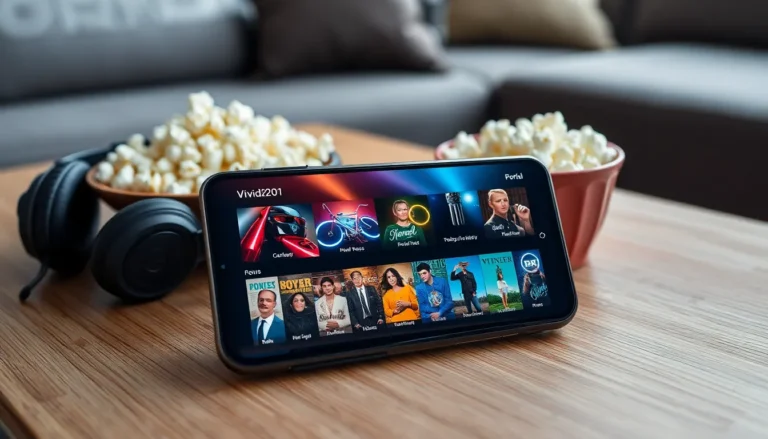Imagine a world where your toaster knows just how crispy you like your bread and your fridge reminds you to buy milk—welcome to the Internet of Things (IoT). This tech marvel isn’t just a sci-fi fantasy; it’s transforming everyday life and business operations in ways that are downright mind-blowing.
In this article, we’ll dive into a fascinating case study that showcases how IoT is reshaping industries, enhancing efficiency, and even saving lives. From smart homes to connected factories, the possibilities are endless. Buckle up as we explore the clever innovations that make our lives easier and, let’s be honest, a little more fun! Get ready to discover why IoT isn’t just a buzzword; it’s the future knocking at your door—hopefully, with a freshly toasted bagel in hand.
Table of Contents
ToggleOverview of Internet of Things
Internet of Things (IoT) refers to the network of interconnected devices that gather and share data. These devices include everyday objects such as appliances, vehicles, and wearables. Each device utilizes sensors and software to connect to the internet, creating a seamless flow of information.
Innovations in IoT enable remote monitoring and control. Smart home technology allows users to manage lighting, heating, and security systems from a smartphone. Fitness trackers help individuals monitor health metrics, providing insights into various aspects of their wellness.
Businesses leverage IoT to enhance operational efficiency. Connected machinery in factories streamlines production processes, reducing downtime. Supply chain management benefits from real-time tracking, ensuring timely deliveries and inventory management.
Security concerns arise with widespread IoT adoption. Data breaches could expose sensitive information, making robust security measures essential. Organizations must implement strategies to safeguard connected devices from cyber threats.
The healthcare sector experiences significant transformations through IoT applications. Remote patient monitoring devices facilitate continuous health assessment, allowing timely interventions. IoT enhances medication adherence through smart pill dispensers that remind patients when to take their medications.
Challenges persist in the IoT landscape. Interoperability issues among devices hinder seamless integration. Standardization across platforms would improve compatibility and user experience.
Each of these elements illustrates the profound impact of IoT on daily life and industry. As technology evolves, the possibilities for IoT applications continue to expand, driving innovation across multiple sectors.
Key Components of IoT

Key components of the Internet of Things (IoT) include sensors, actuators, and connectivity protocols, which play essential roles in creating intelligent systems. Understanding these elements provides insight into how IoT effectively transforms various industries.
Sensors and Actuators
Sensors detect physical phenomena such as temperature, light, or motion. These devices capture data from the environment and convert it into a digital format. Actuators, on the other hand, serve as the response mechanism. They receive signals from processors and carry out physical actions, like opening a valve or adjusting a thermostat. Together, sensors and actuators enable real-time interaction with the environment, facilitating automated responses based on specific conditions. This interaction creates opportunities for enhanced efficiency and smarter decision-making in applications like smart homes and industrial automation.
Connectivity Protocols
Connectivity protocols establish communication between IoT devices and the internet. These protocols, such as MQTT, CoAP, and HTTP, dictate how data is transmitted and received. Each protocol suits different use cases, ensuring devices communicate effectively across networks. For instance, MQTT excels in low-bandwidth, high-latency environments, while CoAP is ideal for constrained devices requiring minimal overhead. Reliable connectivity remains crucial for functionality and performance in IoT systems. Selecting the appropriate protocol guarantees seamless device integration and enhances operational efficiency.
Real-World IoT Case Studies
Numerous real-world applications of the Internet of Things showcase its impact across various sectors.
Case Study 1: Smart Home Technology
Smart home technology demonstrates how IoT enhances daily living. Devices like smart thermostats enable homeowners to control temperature settings remotely, resulting in energy savings. Security systems equipped with IoT sensors can alert users of potential intrusions, increasing safety. Voice-activated assistants streamline control of multiple devices, enhancing convenience. According to a 2022 report, smart home technologies saved users an average of 20% on energy bills annually, underscoring the financial benefits and improved efficiency of IoT in homes.
Case Study 2: Industrial IoT
Industrial IoT transforms manufacturing processes through connectivity and data analytics. Factories equipped with smart machines monitor performance in real-time, reducing downtime by identifying maintenance needs proactively. Logistics management benefits from IoT with real-time tracking of shipments, improving inventory accuracy. Research from the International Data Corporation indicates that companies leveraging IoT in their operations reported a 30% increase in productivity. Streamlined operations emerge as a direct result of data-driven insights, showcasing the value of IoT.
Case Study 3: Healthcare Applications
Healthcare applications of IoT significantly enhance patient care. Remote monitoring tools allow healthcare providers to track vital signs, improving response times during emergencies. Smart pill dispensers remind patients when to take medications, promoting adherence to treatment plans. A study conducted by the American Telemedicine Association found that remote monitoring reduces hospital readmission rates by 20%. These applications demonstrate how IoT contributes to better health management and outcomes, making a profound impact in the healthcare sector.
Challenges and Solutions
IoT adoption presents distinct challenges that require comprehensive solutions. Two significant areas of concern include security and data management.
Security Concerns
Security risks rank among the most pressing issues in IoT implementation. Unauthorized access to connected devices could expose sensitive data. Effective encryption protocols must protect information as it travels between devices. Regular software updates enhance security by mitigating vulnerabilities. Organizations can employ network segmentation to isolate IoT devices from other systems, reducing the risk of widespread breaches. Additionally, user authentication measures, such as two-factor authentication, fortify access controls and enhance overall system integrity.
Data Management
Data management challenges arise as IoT generates vast amounts of information. The sheer volume necessitates robust storage solutions capable of handling fluctuations in data flow. Analytics platforms play a critical role in processing and interpreting this data, leading to actionable insights. Real-time analytics allows businesses to make informed decisions based on current trends and patterns. Standardization of data formats facilitates interoperability between different devices and systems, improving data sharing. Effective governance frameworks should oversee data usage, ensuring compliance with regulations and protecting consumer privacy.
The Internet of Things is revolutionizing how people interact with technology and how businesses operate. Its ability to connect devices and gather data is creating smarter environments that enhance efficiency and improve quality of life. As industries continue to embrace IoT solutions, the potential for innovation grows exponentially.
While challenges like security and interoperability remain, the advancements in IoT technology are paving the way for a more connected future. From smart homes to healthcare solutions, the impact of IoT is profound and far-reaching. Embracing these changes will not only streamline operations but also foster a safer and more efficient world. The journey of IoT is just beginning, and its future holds endless possibilities.


